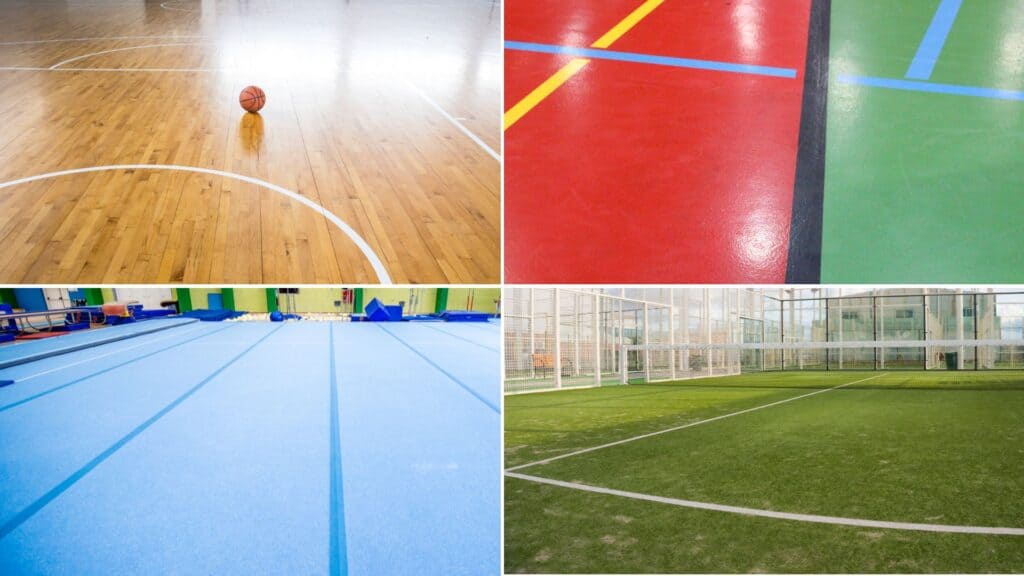The Importance of Choosing the Right Surface for Different Sports (Intro)
The correct choice of flooring for your sports hall is essential, something you should consider an important investment. For the safety of the athletes and the decoration of the sports hall, flooring must meet specific standards. It must meet the needs of its users. In the past, sports hall floors were made from wood or vinyl composition tiles. With the evolution of technology, there are many choices of sports flooring on the market. What are the different surfaces for different sports?
It is important to choose the right flooring for a specific purpose. This depends on a few parameters: the type of sport, the conditions of use and the other activities carried out on the floor. This article will introduce you to the different floor surfaces suitable for each type of sport. Once you read this article, you will be able to better assess which flooring suits your requirements.
What are the requirements and standards for sports flooring?
The right flooring solution depends on a few factors: shock absorption, grip, ball bounce and vertical deformation. These factors depend on the type of sports floor: surface elasticity, point elasticity and combined elasticity.
Characteristics of sports flooring
• Surface elasticity: a soft floor that can exhibit a wide range of floor deformation in the form of a deflection cone.
• Point elasticity: this is the synthetic system where the floor is flexible. The deformation can be observed on a surface related to a specific area where the weight is much higher.
• Combined elasticity: this is the synthesis of the other two categories. It is the type of ground with surface elasticity and a point elastic surface. The deformation zone is very large and is located at the level of the weight distribution layer. In the centre, the deformation is in a specific area where the weight is important. The deformation of the ground is point-like and located on the surface under an athlete’s load.
Shock absorption
Shock absorption measures the ability of a surface to withstand the force of an impact. Impacts are usually related to the feet, e.g. an athlete running. To keep athletes safe the system must have a high level of shock absorption. It reduces the risk of injuries.
We can measure this according to the ASTM F2569 method, which determines the ideal level of shock absorption when performing a sport or activity on the floor.
Ball Bounce
It is a good idea to assess ball bounce on different sports flooring systems. This is the mechanical property that determines the suitability of a surface for basketball. We can measure this according to the ASTM F2117 method which includes performance level and uniformity level. It is based on the reaction of the ball and its interaction with the surface.
Adhesion or slipperiness
This determines the reaction of a dry surface to a slipping foot. It uses the ASTM E303 method to measure grip based on two parameters: performance and uniformity.
For optimal performance, the sports surface should have a slip score between 80 and 110.
Vertical deformation
It shows the capacity of a surface to deform according to the load it supports. If the deformation of the floor is significant, it can affect the athlete and they may become destabilised and injured. The rolling load resistance is 150 kg for a sports floor.

Different surfaces for different sports
Hard surfaces
These are surfaces that use concrete, resin or asphalt in their construction. They are ideal for small wheel sports: scooters, skateboards or rollerblades.
Flooring with surface damping
Also known as multi-purpose flooring and is commonly used in a sports hall. The deformation of the floor is localised on a surface larger than the pressure point. Meeting the NF 14-904 standard, they are hard on contact and soft by design. In terms of cushioning, they are effective.
This type of surface is suitable for sports requiring energy return and rebound, such as basketball, handball, futsal, and volleyball. It is also suitable for sports requiring the lowest possible ground penetration such as scooters, rollerblades or skateboards. It is perfect for parasports.
Parquet flooring
They have a hard-wear layer, ideal for bearings, and an overall design that offers comfort and flexibility.
Parquet flooring is recommended for ball sports: handball, basketball, parasports, etc.
Plastic tiling
This can be used for roller hockey, as it has an excellent puck circulation quality. It should have a very hard finish and a sub-construction with minimal deformation. For this to be successful, it is necessary to focus on the thickness of the foam backing, including its density and its reflex.
Type of sport adapted to these surfaces: hockey, rollerblading, and sports with small wheels.
Polyurethane
This is the flooring material typically used for athletics tracks, walking tracks and running tracks. It is characterised by its flexibility and high shock absorption capacity. This surface offers comfort and confidence to athletes. It prevents injuries and minimises the risk of accidents. It has a strong grip, making it durable. Approved by the IAAF, it can be used for many years without a reduction in performance.
The price varies according to the area to be covered and colour preferences.
Sports suited to this surface: athletics, running sports, aerobics, dance, volleyball, basketball, and gymnastics.
Rubber Flooring
Rubber flooring has a high static load capacity. It can be used under benches and is often used in a gym as it has a superior shock absorption capacity.
Synthetic Flooring
Synthetic flooring is suitable for multi-use athletic applications.
Multi-purpose vinyl flooring offers shock absorption capabilities, an excellent solution for a sports hall. It offers superior cushioning for player safety and comfort.
Hardwood flooring
The most traditional form of sports flooring is still widely used today. Maple hardwood offers tremendous shock absorption. Its natural quality provides a resilient surface for various sports. It is designed to provide uniform traction and grip. Durable and flexible, this type of flooring is easy to maintain.
It is suitable for basketball, squash courts, aerobics studios, dance studios and all gymnastic activities.
Linoleum
This natural surface material provides a durable indoor surface, especially for school gymnasiums. It can withstand extreme abrasion. No need for waxing, it is bacteria-resistant and easy to maintain.
This type of surface is suitable for general fitness, parasport, rollerblading, etc.
Summary
There are many types of flooring to suit your specific requirements. The choice depends mainly on the types of activities that you want to offer at your facility. To make the right choice, you should consider the different parameters and factors for the proper use of the gym floor.
To comment on the article, please proceed to the Telegram post. We encourage you to read our comprehensive article “How To Choose Gym Flooring“.
Disclaimer: The opinions and positions expressed in this publication are those of the authors and collaborators and do not necessarily reflect the views or policies of the professional fitness community.

